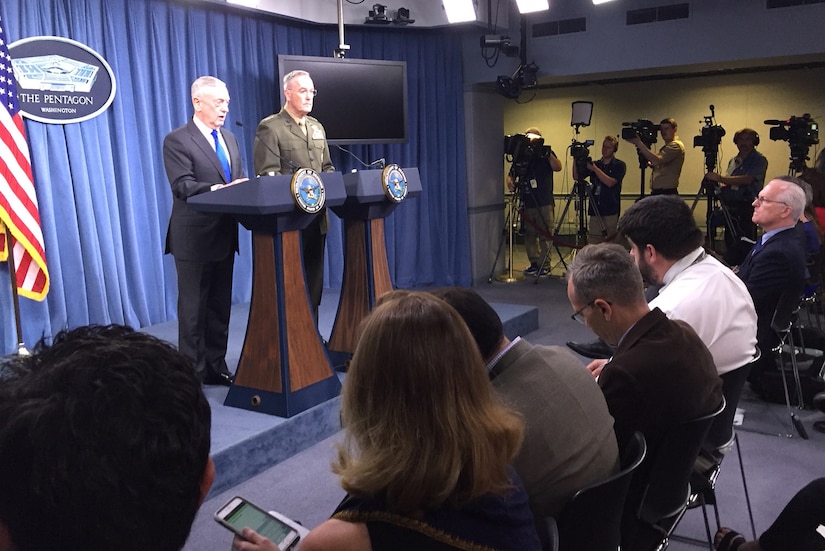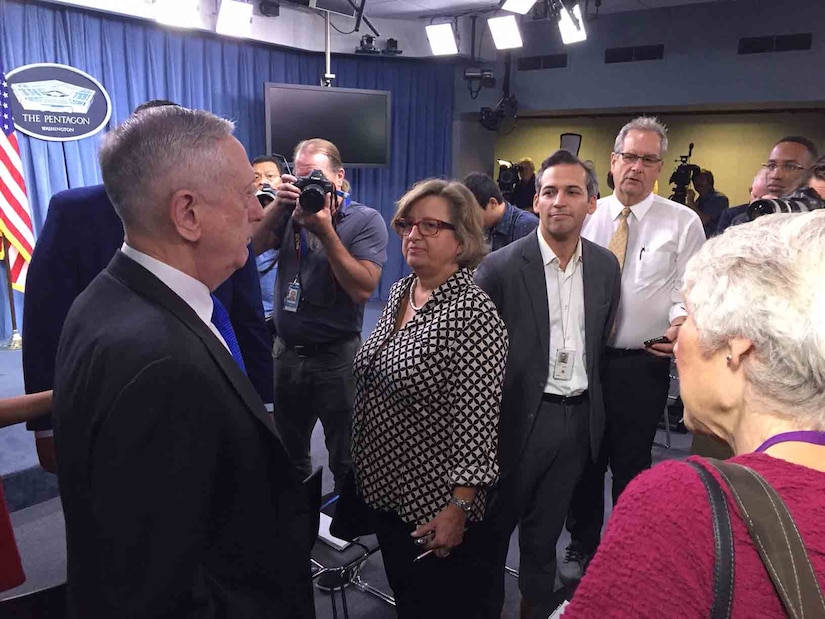By Jim Garamone, DoD News, Defense Media Activity
WASHINGTON -- The chairman of the Joint Chiefs of Staff gave
a snapshot of the width and breadth of the U.S. military’s commitment around
the globe during a Pentagon press conference today.
Dunford discussed the American military’s presence in the
Indo-Pacific region, where 28,000 American service members remain on watch
along the 38th parallel in Korea. “Our priority in the U.S. Indo-Pacific
Command is supporting the State Department-led diplomatic and economic efforts
aimed at denuclearization of the Korean peninsula,” he said.
American troops stationed in Korea demonstrate the nation’s
commitment to the U.S.-South Korean alliance and deter North Korea from
adventurism, the chairman said. The United States is also conducting air and
sea operations to enforce United Nations Security Council Resolutions aimed at
getting North Korea to change its ways. All these are done with partners and
allies, he said.
The United States is conducting operations across the
command -- which covers 51 percent of the globe -- are aimed at preserving the
rules-based international order that has allowed the region to peacefully grow
and prosper, he said.
U.S. Indo-Pacific Command oversees programs to train, advise
and assist forces in internal security, counter-narcotics and counterterrorism
operations, the chairman said.
The chairman shifted focus to U.S. Central Command where
American forces are in contact, seeking to defeat the Islamic State of Iraq and
Syria and training Afghan forces to protect and police their own country.
Central Command also works to counter Iranian malign influence around the
region and deter the leaders of that country from making provocative moves.
There are about 14,000 U.S. personnel deployed to
Afghanistan in the counterterrorism operations and in NATO’s Resolute Support
Mission.
“Our primary mission remains countering terrorist threats to
the United States,” Dunford said. “Our forces, alongside forces from 40 NATO
and partner nations, are also training, advising and assisting more than
300,000 Afghan forces who are responsible for security in Afghanistan.”
The coalition committed to the defeat of the Islamic State
of Iraq and Syria consists of the United States and 76 other nations. “In
Syria, 2,000 U.S. and additional coalition forces are working to enable the
50,000 Syrian Democratic Forces in clearing the remainder of ISIS from the
Euphrates River valley and in stabilizing those areas that have been cleared of
ISIS,” the general said.
Across the border, American forces work with Iraqi security
forces to ensure the success they have had is enduring.
Russian actions in Crimea and the Ukraine have caused
consternation across Europe, and U.S. European Command is deeply involved in
reassuring allies and deterring Russia. American forces have deployed to the
Baltic Republics and Poland where they work with allies on exercises to
increase interoperability. “This year we have conducted 13 joint exercises in
Europe in addition to a wide range of service specific training and
engagement,” Dunford said.
In U.S. Africa Command, there are 7,200 U.S. forces supporting
thousands upon thousands of African partners in their struggle against terror
groups like al-Qaida, Boko Haram and offshoots of ISIS. “Our efforts include
developing security forces in Somalia, countering ISIS in Libya and supporting
partners in the Sahel and the Lake Chad regions,” Dunford said.
The chairman shifted to U.S. Southern Command where American
military leaders work with allies to address regional challenges and threats.
Transnational criminal gangs, narcotics and people smugglers and the refugee
crisis around Venezuela concern all in the hemisphere.
“Finally, here at home, the U.S. Northern Command has 1,600
DoD personnel and 33 aircraft working to suppress wildfires in the Western
states, while more than 2,000 Guardsmen are supporting [the Department of]
Homeland Security on the southern border,” he said. “The Northern Command also
provides around the clock ballistic missile defense, while Americans and
Canadians from the North American Aerospace Defense Command defend our air
space.”
And, as worldwide operations and exercises continue, U.S.
forces must adapt and innovate, the general said.
“Our efforts include a series of globally integrated
exercises and experiments to help shape the force we will need to fight and win
tomorrow,” he said.








